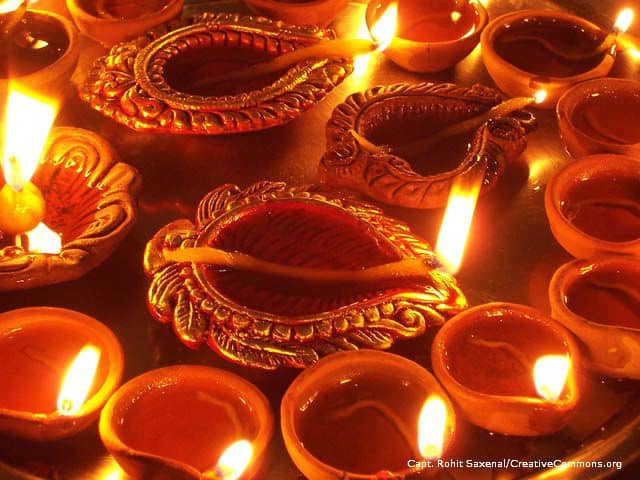 Pre-puja, I washed my 2003 Toyota Matrix. Later, outside my Hindu temple, the pujari and several of my friends gathered for the ceremony.
Pre-puja, I washed my 2003 Toyota Matrix. Later, outside my Hindu temple, the pujari and several of my friends gathered for the ceremony.
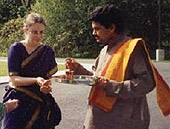 Step 1: The first thing I did was accept holy water into my right hand and wash my hands for the puja. This was repeated three times. In temples it is a rule to accept things with the right hand, placing your left hand under it.
Step 1: The first thing I did was accept holy water into my right hand and wash my hands for the puja. This was repeated three times. In temples it is a rule to accept things with the right hand, placing your left hand under it.
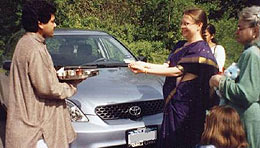 Step 2: For three repetitions, I accepted rice from the pujari to sprinkle onto the front of the car.
Step 2: For three repetitions, I accepted rice from the pujari to sprinkle onto the front of the car. 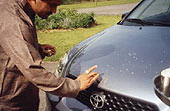 Step 3: Using turmeric powder mixed with water, the pujari drew a swastika on the car with the third finger of his right hand (an auspicious finger). It does not stain the car. It can also be drawn with sandalwood paste.
Step 3: Using turmeric powder mixed with water, the pujari drew a swastika on the car with the third finger of his right hand (an auspicious finger). It does not stain the car. It can also be drawn with sandalwood paste.For Hindus, the swastika has been a good luck symbol for thousands of years. It means "to be well." Hindus look back to this traditional meaning, rather than its 20th-century connotations, during ceremonies.
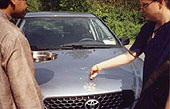 Step 4: After the swastika was drawn, I was again given rice to bless the swastika by sprinking rice on it. For each of the three sprinkles, I was given mantras to recite. In Step 5, I meditated on Lord Ganesha and recited holy mantras, including about 11 of Ganesha's 1008 names.
Step 4: After the swastika was drawn, I was again given rice to bless the swastika by sprinking rice on it. For each of the three sprinkles, I was given mantras to recite. In Step 5, I meditated on Lord Ganesha and recited holy mantras, including about 11 of Ganesha's 1008 names.
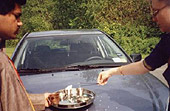
Step 6: Next, I lit incense sticks. The pujari took these and circled them around the swastika three times in a clockwise direction, then took the sticks inside the car and circled them around the steering wheel three times in a clockwise direction, reciting mantras.
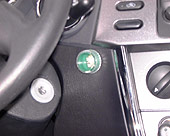 Step 7: The pujari installed a small Ganesha idol to the right of the steering wheel. This is not ordinarily part of the ritual, and I had to provide the idol. To install this Ganesha, there was a short (5-minute) puja.
Step 7: The pujari installed a small Ganesha idol to the right of the steering wheel. This is not ordinarily part of the ritual, and I had to provide the idol. To install this Ganesha, there was a short (5-minute) puja.Three times in a row, the pujari opened the small plastic case enclosing the flat silver Ganesha, had me put holy water inside it, and then had me put rice in it. Finally, he took out the rice and left three grains in it, closed the plastic case, and attached the idol to the dashboard behind the steering wheel (the idol should be located where the driver can see it).
Step 8: Back outside the car, we performed the coconut-breaking part of the ritual. I broke the coconut near the right front tire and sprinkled coconut water on the tire. The coconut is kept as prasadam (a holy food offering given to God during pujas) and eaten later.
Step 9: The last step involved breaking lemons by driving over them and circling around three times. I gave the pujari four lemons, and he put one under each tire. I got into the car and drove it to the right. There was a roundabout driveway in front of the temple, which I circled once. The breaking lemons symbolize the ridding of bad influences from the vehicle. Some people drive around three times, and in some locations, like the Lakshmi Temple in Boston, the driver will circle the temple itself.
Participating in this puja was a calming experience for me. I also was happy to share this experience with my mother, niece, and a good friend. Although I'd attended a car puja some years ago, I came to understand this puja more after having been the main participant myself.
Planning a Car Puja
Call your local Hindu Temple and ask to set up an appointment. This is not always necesary, but it is a good thing to do so you don't show up on a holy day, when you might not be able to get the pujari's time. In addition to setting up the time, ask about the fee. Mine cost $31 dollars (usually the fee will end in "1"; even amounts are not considered auspicious). Also, ask what items you should bring, such as the four lemons and the coconut (the idol is optional). The rice and other items are provided by the temple.
